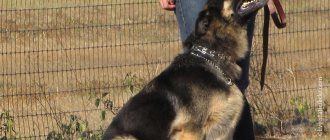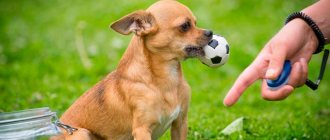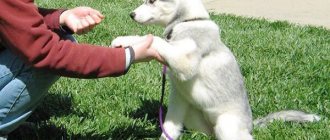Choosing a name for a puppy and teaching it to a nickname is perhaps the most enjoyable and at the same time difficult part in raising a four-legged animal. It seems to the owners that choosing a nickname is very easy, because among the variety of already invented names, in any case, there is one that is guaranteed to suit a new friend. However, problems begin already at this stage, especially in a large family, where everyone strives to “call” the puppy in their own way. Moreover, it is not enough to choose a name: it is also important to figure out how to accustom the dog to a nickname so that everything goes quickly and without much hassle. But first things first.
How to train a dog to have a nickname?
A nickname from the pedigree or a new name?
If the owner decides to get a purebred puppy, it will be accompanied by a pedigree, where most often the baby’s name is already indicated. Also, the name of the nursery or a prefix is added to the nickname, proving the thoroughbred of the owner. Because of this set, one name can consist of two/three or more words.
Any purebred dog has a documented pedigree
As a rule, such official nicknames are difficult to pronounce and difficult to understand, especially for a small puppy. But there are two ways out of this situation:
- Name the puppy a simpler and shorter version of the nickname from the pedigree. Thus, the long and incredibly beautiful name of the German shepherd Adeline-Denise of the Viscount Strauss Family easily turns into the nickname Ada or Denis.
- Discuss the puppy's name with the breeder first. If the owner knows in advance which kennel he will take the dog from, he can contact the breeder. He will invite the future owner to come up with a nickname for a certain letter, which will be recorded in the metric. This strange ritual is easy to explain: all breeders keep records of newly born puppies, and give them nicknames in accordance with the litter. Each new litter is assigned its own letter of the alphabet, and one nickname can only be given once every 30 years.
Immediately after a pet appears in the house, a person begins to address it only by its nickname, provided that it has already been invented in advance and has suited all family members, including the dog. However, most often the owners want to come up with a nickname for their new friend, without paying attention to the pedigree.
An obedient and unafraid puppy will run to its owner at his first call.
How to name a puppy without reference to pedigree
Despite the fact that the choice of names for dogs is quite extensive, puppies can live in a family for a long time under the name “dog”, “small”, “fat” and other cute but frivolous nicknames. In order not to confuse the baby, you need to immediately decide on a nickname. The rules in the table below will help you choose the right name.
Table 1. What should you pay attention to when coming up with a name for your dog?
| Choosing a nickname | Justifications |
| Sonority and length of nickname | It is best to choose a short nickname, no more than 2-3 syllables. Words with hard letters instead of hissing ones, as well as with bright endings, are recommended. For example, Brig. |
| Phonetics of nicknames | Dog handlers believe that the friendliness of the dog depends on the softness of the nickname. So, if the nickname consists of hard, sonorous letters (Brig, Greta, Richard, Hera), then the dog will grow up with a tougher character. And puppies with soft letters in their names (Mila, Veta, Bounty, Luke, Lada) behave more affectionately. This theory can be explained: after all, in the first case, calling the dog turns out to be more aggressive and strict, and in the second - more affectionate and soothing. It is not surprising that the dog will react accordingly. |
| Level of pronunciation and perception | After the nickname becomes familiar, some derivative pet names may appear from it. However, the main name should be constant, easy to pronounce and simple for the animal to understand. |
| Breed and character of the dog | Still, the fundamental factors for the development of character are genetics and early learning. Therefore, before “calling” your baby, monitor his temperament. A defender who fearlessly barks at any threat can safely bear the name Thunderstorm, while an eccentric and active one can bear the nickname Storm. And the affectionate cute puppy can be called Baby or Bounty. |
| Gender of the dog | Nicknames for male dogs are not suitable for female dogs. |
| Avoid names that your previous pets had | All the past should remain in the past, and before you is a new friend with his own unique character and unique habits. |
Subconsciously, a person understands that each nickname leaves a unique imprint on its owner. After all, the dog’s future character, attitude towards the world around him, and the dog’s level of sociability depend on how the owner calls the puppy. As the old children's song says, “Whatever you call a ship, that’s how it will sail.” So it is in the animal world - one dog will slowly swim through life, and the other will fight and show character. Therefore, when coming up with a nickname, remember that you are choosing the future for your baby.
Why not call this kindest, friendly dog Laska?
Video - How to choose a nickname for a puppy
Tips for choosing a nickname
Breeders call purebred animals because this is necessary to obtain a puppy card. The owners can either get used to the chosen option or come up with something of their own.
Leave a name from the pedigree
In the St. Petersburg kennel "Octales", which breeds chow-chows, you can find puppies Octales Terra Incognita and Octales Peerless Berta. The main disadvantage of such intricate designs is their bulkiness. They are difficult to pronounce and remember, so in the family circle the owners shorten them to Terra and Bertha.
If you managed to get in line before the puppies were born, then you can choose the possible options yourself. The only limitation is the first letter. It depends on the order of the litter. The very first one is called strictly with the letter “A”, and all the rest are then in alphabetical order.
Come up with a new name
In most cases, owners come up with something on their own, guided by their imagination. In this case, you should adhere to the following recommendations:
- Simplicity. The easiest words to remember are words of 1-3 syllables.
- Sound clarity. Focus on voiced consonants.
- Lack of similarity with the teams (“Fas” - Fast, “No” - Seth, “Place” - Pesto).
You shouldn't name your new pet after someone who died. A constant reminder of a friend who has passed away will not lead to anything good.
ADVICE!
Take your pet's appearance or character as a basis. Read more about what name you can give your baby in our article.
Is it possible to give an animal several names?
Animals remember up to 4 options, so they can be divided into “bad” and “good”. The former should be used strictly for punishment, and the latter for encouragement and during normal communication.
When to start nickname training and why?
So, long discussions and lengthy family negotiations yielded results, and the puppy finally had a name. Now you need to accustom the baby to his nickname. This is a very important stage of education on which further training is built. The principles of the basics of training will be as follows:
- Experts advise starting training for a nickname at about 2-2.5 months, that is, at the time when a new inhabitant first appears in the house.
- Some dog owners are sure that they only need to train a response to a name with a 3-month-old puppy, but practice shows that this is too late. At 3-4 months, the dog is already able to learn more complex commands under the guidance of the owner or instructor.
- If a dog was adopted from the street as an adult, it must be taught its name immediately. Already formed animals are capable of learning no worse than puppies.
Some tips for choosing a name for a dog
Don't forget that it takes time for a puppy to learn the correct response to his name. It is necessary to achieve a situation where the dog, having heard the name, turns its head towards the one who called it. In the future, you can work out the link:
- pronouncing the nickname - the dog raises its ears and turns to the owner;
- command – the pet follows the order and continues to look at the owner.
Important! When choosing a nickname, you should avoid human names, otherwise an ambiguous situation may occur on one of the walks. The owner of the name may think that the person is addressing him and not his puppy, and may react inappropriately to such a tactless situation.
Training the response to a small dachshund's name while feeding
Rules for teaching a puppy a nickname
There are several rules that owners should follow when training obedience in a small dog. They look like this:
Rule 1. A nickname is the first thing a dog should learn to use.
The sooner the puppy is accustomed to its name, the better. An unconditional response to a name is the basis for the development of devotion, a guarantor of the dog’s ability to learn and be well-mannered. Saying a nickname should distract the animal from all the things it is doing and shift the focus to the owner anywhere - at home, on a walk or while playing.
The puppy has learned to shift the emphasis to the owner
Rule 2. Nickname = command “Attention”
For any dog, its name should become an analogue of a signal for attention. That is, after the animal hears its name, it should become alert, turn to the owner and wait for further instructions. Perhaps the owner will give an order or praise the pet.
At the second stage, you need to teach the puppy to come to the owner when he calls him by name. After each correct reaction, you need to cheer up the baby by treating him with a piece of cheese, a cracker, a dog biscuit or another favorite treat.
Children can take an active part in raising a non-aggressive dog
Rule 3. No diminutive forms
Affectionate derivatives of the nickname will still appear in the owner’s speech, but you should not give the puppy a reason to perceive them as a command. An adult dog may develop the habit of responding to several forms of handling at once, but with a puppy you only need to train one.
The initial stage of training is the period when you need to call the puppy by name each time. During games, stroking, eating, you cannot address the animal as “hey, you”, “baby” and so on, you need to clearly pronounce the name. Then the dog will quickly remember the desired combination of sounds and get used to the phrase after which he needs to react.
Rule 4. Reward follows only after the command
The puppy should not be praised every time he looks at a person, but only after responding to a command. This way he will quickly understand that obedience brings “goodies.” Over time, the treat is offered less and less, and then completely replaced with simple praise - pleasant words or stroking.
Video - How to teach a puppy its name
How many names can a dog have?
Of course, it is better if at first, especially at the training stage, you always pronounce the name the same way so that the dog does not get confused. However, many dog owners will say that their pets respond to many names with ease. And indeed, sometimes dogs begin to perceive any kind words addressed to them in the same way as their own name. There are dogs that respond to dozens of nicknames! And even cases when owners publish a book - a collection of names of their beloved dog.
My dogs have always responded to many names. It always seemed that those who were born with one name and still live with it were somehow not very lucky. Boring - no variety! Of course, I didn’t undertake to make everyone happy, but where it depended on me, I boldly took matters into my own hands.
For example, my dog Ellie had so many names that one day when I decided to count them, I simply lost count. She even became Fukinella Dulsineevna - she grew up to be a patronymic. Moreover, if I asked: “And who is Fukinella Dulsineevna? And where is she? — the dog looked faithfully into my face, twirled its tail so that it seemed like it would come off, pressed its ears and smiled broadly. So that no one is left with the slightest doubt: here she, Dulcina’s very own Fuchinella, stands like a leaf in front of the grass, waiting for further instructions! And you don’t even have to look for more Dulcinee Fuquinellas!
And why and where different names of dogs come from, the owners themselves cannot say. Apparently, this is too spontaneous a creative process that cannot be analyzed.
How to train a dog to have a nickname: step-by-step instructions
After the rules have been studied, a nickname has been invented, and the puppy is already fully accustomed to the new apartment, it’s time to start training. The step-by-step algorithm of the simplest method will look like this:
- The action takes place in a confined space (in a room or in the courtyard of a private house) so that the dog does not run away. You need to take a treat in your hand and move a few meters away from the puppy.
- Say the nickname loudly and clearly several times. There is no need to shout, make your voice stern or raise it too high, otherwise the dog will be afraid of its name.
- The dog may not respond right away, and that's okay. It is enough to show a piece of treat and call your pet again. When he approaches, feed him a treat and praise him. While the baby is eating the “yummy” treat, you need to pat his fur and repeat his name several times.
- In order for the team to understand it well, it is better to repeat the lesson several times. The owner’s task is to reinforce in the puppy’s mind the fact that after the name sounds, some actions occur, so it needs to be responded to.
The main goal is to awaken in the puppy's head the relationship between saying the name and the pleasant emotions that follow.
You need to call a dog affectionately, it should love its name: this way the dog will respond much more willingly than to an owner who screams and stomps his feet.
Once a habit is developed, the rewards are gradually reduced to zero. For an already trained dog, the nickname is intended to sound not as a signal to receive “goodies”, but as a reason to immediately pay attention to the owner or the one who calls it.
Training your reaction to a nickname while walking
How to teach a dog to respond to a name?
First of all, take your time and divide the entire learning process into simple steps. Thanks to the step-by-step plan, you will easily achieve your goal.
The main thing is that you need to start training a puppy or dog in a quiet place and in a calm environment, where no one and nothing can distract it from the process. It’s best at home, face to face, so to speak, in the absence of guests and even other family members, for example, noisy and cheerful children.
As soon as the dog begins to respond to his name, you can complicate the training. Practice outside, in the presence of other people and various distractions (birds, bicycles, other people's children).
Step one: set a goal
This stage is often skipped during training - a serious mistake! Before you start learning any command, you need to think about not only how it will sound (in this case, it will be the name of the dog). It is necessary to determine what its flawless execution should look like.
In this case, we will strive to ensure that the dog makes eye contact with the owner as soon as he hears his name. Thus. she will focus her attention on the person and wait until the owner gives a reward or demands to do something else, to perform some other command.
By saying the name of a puppy or dog out loud, a person seems to be telling him, look at me, I want you to do something.
In other words, your goal is to get the dog to look at you when you say its name out loud.
Stage two: preparing accessories and treats
A clicker is a very useful accessory for dog training that makes a light click. Using it correctly, you can train your pet faster.
If you don't have a clicker, replace the click with praise. Be emotional, show that you are happy with your dog. Let it be joy and delight, but not excessively, of course. Remember that learning requires a calm environment.
Prepare treats - it is better to give the dog, and especially the puppy, small soft pieces of something tasty. So that the pet does not have to chew on its reward for too long. Let it be chopped cheese.
Stage three: say the name and wait for the look
Remember, it is quite difficult for a dog to look a person in the eyes. The animal experiences discomfort. Especially if the pet has recently appeared in your home and has not yet learned to fully trust its owner. Therefore, do not immediately demand eye contact from the dog, and do not be upset if the puppy does not look at you the first time.
Communicate with the baby; it is better to start training the dog while playing.
If you managed to attract the pet’s attention, and the dog looked into your eyes at least briefly, immediately use the clicker, praise and give a reward.
Several ways to teach your dog a name
Dog owners who do not have much experience in raising four-legged dogs often complain that their pet does not respond to its name. In such situations, you should be patient: not all kids pick up commands on the fly. After a few days or weeks (depending on the persistence of the owner and the intelligence of the animal), the puppy will begin to understand its name.
To make learning more effective and faster, you can use other learning methods. All of them are presented in the table below.
Table 2. Methods for teaching a puppy a nickname.
| Type of training | Process description |
| Lessons on a walk | For the lesson, you need to choose a quiet, deserted place without any irritants. You should not let your dog off the leash: it will be safer this way. Release the leash and let the dog go a few meters, then say the name loudly. If the dog does not respond, pull the leash. When the dog approaches, give it a treat. It is better to repeat the lesson several times. |
| Learning by playing | Any well-fed and healthy dog doesn’t mind playing, so why shouldn’t the owner use this feature for his own purposes. The owner picks up the dog’s favorite toy and, attracting its attention, pronounces the puppy’s name. When the baby runs up, you need to praise him and play a little. Then perform the ritual again. |
| Repeating nicknames before and during meals | You will need a hungry puppy and a bowl of food. While not far from the puppy, you need to pick up the bowl, lift it, and call the puppy by name. Only after he approaches, put the food near you, pet the puppy when he starts eating, and say the name a few more times. It is enough to repeat this activity twice, and for the third time the hungry puppy will run to the owner simply after the mention of the name. |
| Hand feeding | The algorithm is the same as when feeding from a bowl, only it will be more pleasant for the puppy to eat food from the owner’s hands. You need to take the food in your hand, squat down and call the puppy by name. When he runs up, pet him and let him eat the food. In this way, you can teach a puppy a nickname even in one day. |
| Weasel | The owner takes the little puppy in his arms and strokes it. While he is basking in human arms, the owner affectionately repeats the dog’s name and strokes it. |
| Help from relatives/friends | A method that will be useful if the owner has a business trip or vacation coming up, and the puppy has to be left with his family. The helpers disperse to different areas in the same room and take turns calling the puppy to them. At first, the reward may be a piece of treat, and later - only praise. The puppy must get used to the voice of strangers if he is to stay with them. |
During the lesson, the puppy may not approach the food bowl - on the first and second days of his arrival in the house, this may be normal. In this case, you need to bring the bowl to the puppy's face, let him smell the food and put it back. When the dog runs up, you should praise him. After this, call the pet’s name a few more times and pet it, then leave and let it eat in peace. Usually, babies quickly understand that their nickname sounds every time the owner wants to feed the puppy.
Important! If none of the methods brings the desired result, just wait until the puppy gets hungry. A hungry baby will respond to any command when it sees something tasty in the hands of its owner.
Teaching your puppy his name while eating
What to do if the dog refuses to look its owner in the eye?
It happens that a dog does not want to look its owner in the eyes. She gets distracted by the treat you prepared for her and stares at the bag of treats or your hands.
Try to encourage your pet to look at you. Repeat his name again and additionally smack your lips or whistle. Believe me, not a single puppy or dog in the world can resist these sounds; they will definitely catch your eye at least out of the corner of their eye.
Reward your pet only when he looks at you. Repeat this exercise until you achieve your goal: the dog looks at you when you say its name out loud.
Stage four: complicate the exercise
If your dog already looks at you boldly every time he hears his name, it's time to start demanding a little more from him.
The moment your pet looks at you, wait a second before praising him or rewarding him with a treat. Repeat this several times.
Next, increase the time, wait two seconds. It is not worth delaying the reward longer than this period of time. Because it is necessary to ensure that the dog does not just look at the owner, but waits for some further instructions from him.
By calling your pet by name, you seem to be telling him: “Hey, look at me, we’re about to do something interesting with you.”
Step Five: Add Distractions
Start saying your dog's name at a time when your pet is not ready for it. After all, he is already accustomed to the environment that you created for him to learn. Now we should change it a little.
Act unexpectedly, for example, at the moment when the dog is sitting comfortably on his favorite bed. Call him by name. The baby is playing happily, chasing the ball around the floor - say his name out loud again.
If everything goes well, then you can go outside. There are a lot of distractions there. First, practice responding to your own name when the dog is walking on a leash.
Then move on to more “difficult” situations. For example, when a pet sniffs something enthusiastically. The reaction to its name should be this: the dog stops, turns to the owner and looks into his eyes.
The same effect should be achieved when the pet runs without a leash and plays with other dogs. If the dog reacts well, it means you have already achieved your goal.
Stage six: consolidation
It should be noted that dogs, like people, tend to forget what they were once taught. Therefore, if you do not use any command for a long time, the dog will stop responding to it.
You need to practice responding to your nickname almost constantly. This reaction must also be reinforced while learning other commands. Yes, giving any command begins with the person attracting the pet’s attention by saying its name out loud.
However, that's not all. It is worthwhile from time to time, during training, to simply call the dog by name, and when it responds, reward it for it. Then the skill will remain in the animal’s memory for many years.
Source
How to accustom an adult dog to a new name
The algorithm for raising an adult stray dog adopted into a family will be the same as when training a puppy. Smart adult dogs can remember a new name in 1-3 days. And if you got the nickname from the previous owners, but the new ones don’t like it, you can use the following tips:
- Inform all relatives and friends who frequently interact with the dog that the pet’s name is changing. Now everyone around should call the Lada “Thunderstorm”, as if nothing had happened.
- During the retraining process, feed the four-legged dog with its favorite “goodies” and praise it when it reacts to the new name. As a rule, the retraining process lasts longer than learning the first nickname.
Teaching an adult dog a new name during lunch
If the nickname is learned, and the pet turns around at the first call without any problems, you can approach the second stage of training - responding to a specific sound. Such training should be introduced only after the dog has matured and become more conscious, otherwise the small dog may simply be confused by the loud commands.
You will need a command that is even shorter than the name, but that attracts the dog’s attention. Many owners use a whistle, but you can choose something else. While walking, when the dog has moved far enough away from the person, you need to whistle and wait for the dog to turn around. After this, the owner names the nickname. If the animal approaches, it is treated with a treat, but a simple turn is enough, for which you need to praise the pet.
With a strong desire and perseverance, you can even train an adult pet to a new name.
How to train a dog to respond to a nickname when he is very busy
It is important to accustom your pet to the fact that the nickname said by the owner is a signal to immediately stop the actions being performed or at least to temporarily switch attention to the person. To develop this skill, a lesson is carried out, performed at a time when the small dog is very busy with something. The principles of such lessons:
- The owner noticed that the puppy was enthusiastically gnawing on an old slipper, not paying attention to what was happening around him. To distract the baby, the owner says his name loudly and offers him a bowl of food.
Dachshund puppy chews shoes
- The animal has no choice but to distract itself from the tasteless slipper and start eating. After several such repetitions, the dog begins to prioritize and understands that it is better to respond to the name and get food than to ignore the owner and be left with nothing.
- This feeding needs to be reduced little by little, and soon the puppy will instantly respond simply to his name. “Persuasion with food” should be used in the future only in cases where the dog begins to forget the skill.
If the puppy really likes to do something with the owner (go for a walk, ride in a car, play), this can be used as encouragement. For example, when the dog responds to its name, the owner can take it for a walk or play with it. This reward will be received with more enthusiasm than a treat or petting.
Little dog is passionate about playing his favorite ball
How to teach a puppy to respond to its name? Here's a step-by-step guide!
Every well-mannered dog should know several basic commands. This makes caring for your pet easier and ensures its safety. You should start by ensuring that the puppy or adult dog (if you adopted it from a shelter or from the street) begins to respond to its own name. Here's a step-by-step guide to teaching your puppy to respond to his name.
Training in 1 day: is it possible?
The two most important things on which quick naming is based are the persistence of the owner and the intelligence of the dog. With proper self-confidence and intensive training, a puppy can be taught to respond even in 1 day. Small dogs, such as Yorkshire terriers, remember new information especially quickly.
Yorkshire Terrier puppy is smart from an early age
In order for your puppy to quickly remember its name, you need to:
- While playing, stroke the puppy and constantly call him by name affectionately. For example: “Alice! Good Alice, dear Alice! My Alice!
- After a few minutes of playing, step back 3-4 steps and call by nickname - “Alice!” Alice!".
- Play with the baby again, calling his name. There is no need to repeat commands more than 5-6 times in a row - let the puppy exhale a little and continue training.
When raising a puppy, it is important to realize that he is still very small and gets tired quickly.
Not all kids are able to concentrate quickly, especially immediately after arriving at a new home. In some cases, the owner may feel that the pupil does not hear the command, and therefore does not respond, but this is not so. Dogs have excellent hearing, and the lack of reaction to a name only indicates that she does not want to do it.
Don't forget to reward your pet if he matches his name
Why can't you teach your puppy a name?
Some dog owners complain about their pets, claiming that they are not able to accept their name, do not give any reaction and look at the owner with confusion. In the first stages of training, this phenomenon is considered quite normal; after a week or two, the puppy will get used to its nickname.
However, if training has been going on for several weeks and there is still no result, the reason may not be the dog’s intelligence. Many owners themselves are to blame for the fact that the puppy cannot remember its name. For example, the reason could be:
- the owners regularly repeat some other affectionate nickname instead of a nickname;
- More and more new variations of nicknames appear, to which the owner waits for a reaction;
- The dog's name is pronounced unclearly or unintelligibly;
- the owner pronounces the nickname in a threatening or overly stern voice;
- the name is said too often, and the puppy stops perceiving it as something special;
- the person tries to attract the dog’s attention by whistling, clapping, or clicking his fingers.
All these situations lead the baby into a dead end, and he does not know what exactly to react to and what exactly his name is. Only one nickname should be used, which must be spoken clearly and clearly.
The four-legged pet should become a good friend and partner for the owner, then training will be easy and joyful
Moreover, whistling and clicking, with which the owner tries to attract attention, are generally prohibited at first. Any passerby on the street can perform a sound familiar to the puppy, and the dog will run to the stranger. This can not only undermine the authority of the owner, but also threaten the health of the dog.
Firstly, the puppy will understand that anyone can call him, even a stranger, and the owner will cease to be a leader in his eyes. Secondly, it is unknown how a stranger feels about dogs - he may get scared and accidentally kick the puppy. And thirdly, the pet can run along the road and get hit by a car.
The puppy should not approach strangers
What is strictly forbidden to do?
During the training process, you should never punish a puppy after approaching its owner. This attitude will achieve the opposite effect: the dog will associate punishment with approaching by name, and next time it will not come or even run away.
For example:
- While on a walk, the dog found some old bone and became interested in eating it, not paying attention to the owner’s commands.
- The owner calls the dog by name, but it takes a few minutes to respond, deciding to throw a tasty bone and still approach.
- After this, the puppy receives punishment.
According to the owner, the dog should understand that it received a scolding due to disobedience. However, the puppy associates punishment with its final action - approaching for its name. Now he will have a clear chain: approach by nickname = punishment. The next time, when the dog hears its name, it will wait for punishment and will never approach its owner.
You should never yell at a dog, either as a puppy or as an adult.
About the process of accustoming to a name
Usually dogs with a pedigree in their nickname get used to it quite quickly. This is a period of three to four days. It must be said hourly at the initial stage. Do this during feeding, going to work, playing, and initial training.
During the day, you must clearly and loudly call the student by name. And when the dog begins to react, to pay attention to the sound of his name, then he must be stroked, encouraged with a treat, again repeating the name. This will speed up the adoption of the nickname. Before feeding, you need to take the dog’s bowl, fill it with food, and say its name. If the dog does not approach, and this can be normal on the first or second day, then the bowl should be brought to the dog’s muzzle, given a sniff, the name pronounced again and the food taken to the feeding area. The dog will definitely come running. Pet him, say something like, “Well done, Ray,” and walk away. Don't stop him from eating.
At the very beginning of the educational process, it is important to develop in the pupil the habit of immediately responding to a nickname. When your dog is distracted by something, for example, by toys, it is imperative to return him to his place or force him to perform the necessary actions by pronouncing his name. Further, in the process of accustoming to various commands, it is recommended to first say the dog’s name, then the order.
Once your pupil has learned his name and will always respond to it, there is no longer any need to reward him with treats. As a rule, by the age of three months the dog already clearly reacts to its name. But the conditions for improving a skill and consolidating it must be gradually complicated. This is done on a walk when the dog is at a long distance. Sometimes even in dog fights on the street, calling the dog should help stop the fight. In this case, the owner’s voice should be raised and stern. But in accustoming to a name, it’s the opposite—soft, but clear and serious. It is the overly threatening pronunciation of a nickname that is considered an upbringing mistake. You should not do this, even if you have a guard or service dog. Dogs have very good hearing. They know how to distinguish the owner’s tone and catch the strict notes in the voice. And you will need such treatment in the future as a punitive function.
Result: what should the trainer achieve?
The desired result is considered achieved if the dog, upon hearing its name, becomes alert and instantly turns its gaze to the owner. Many people believe that such a reaction is not necessary in everyday life, and immediately teach the dog to approach the owner after the name is uttered.
If the dog begins to call when called by its owner, it is necessary to ensure that it begins to approach other inhabitants of the house or apartment. Therefore, all family members should be involved in raising the puppy, otherwise they will not be able to get along with the dog.
So, each family member should take a treat and call the puppy by name several times a day - at least 5. When the baby approaches, they give him a treat, praise him, and the algorithm is repeated with the next person.
Huskies are very smart dogs and quickly learn their names.
Recommendations for properly teaching a puppy its name
Memorizing a puppy's name can be considered the basis for further education and training. The dog must clearly know its own name and react instantly when it hears it from its owner. This behavior is proof of good contact between owner and dog.
Good contact between the owner and his dog is important
To achieve this level, you need to take into account the following recommendations:
- The first thing you need to do is get ready for fruitful work. The owner must restrain his emotions, not be offended, not angry or yell at the dog. It is important to maintain a positive attitude, which will be passed on to your pet during training.
- Dogs are just as susceptible to stress as people. A puppy who is constantly in tension due to the owner's screams will not respond correctly to the name. Moreover, his mental state may suffer. The pet will not only not come up after another cry, he will try to run away from such treatment.
- The same applies to a dog that was taken from the street. The animal did not have a place to sleep or proper food before being brought into the house, which left the animal with psychological trauma. Let the dog sleep, come to its senses, eat enough, and only later start teaching it to commands.
A dog from the street at the initial stage of getting used to the house can behave like this:
- During training, it is important to maintain visual contact with your pet. While the puppy is walking towards the owner, you need to look into his eyes, without looking away while praising him.
- The acquired skill must be reinforced daily, and the dog must be encouraged and praised for the correct reaction. In this case, the reward with a treat gradually ends, and after it the stroking also stops. At the final stage, the dog responds to the name without any additional stimuli.
Stroking and caressing the owner is the best praise for a dog for following the owner’s commands
- When the nickname is completely mastered, you can begin to combine teams. You can pronounce the name of the animal to focus attention, and after that add orders - “to me”, “nearby”, “walk”, “bring” and others.
Important! The dog's name should not become a command: it is used only to transfer the pet's attention. Only after he has learned what he is called is he allowed to begin mastering simple commands. Thus, a stern pronunciation of a nickname cannot be used instead of the command “fu,” and an affectionate one should not become an analogue of the order “come to me.”
About choosing a name for a dog
No matter what age you take a puppy from a kennel, accustoming it to a nickname should begin from the first days of the dog’s stay in your home. The exception is when breeders themselves give the puppies a name in order to facilitate their initial upbringing. But this rarely happens. In most cases, the right to choose a name for a pupil belongs to its owner.
Psychologists say that the sound of one’s own name is a pleasant sensation for a person. Therefore, in order to influence him, it is advised to call the person by name more often. The same goes for dogs. A nickname is the basis of relationships with a student at the initial stage and throughout subsequent life.
The dog's name must correspond to its gender. Dog breeders advise choosing something simple, short and euphonious, that is, easy to pronounce. Even if the name of your breeding puppy is recorded in the pedigree taking into account the father, grandfather and great-grandfather, this does not mean that this is how you will address the dog.
You should not assign human names, nationalities, military ranks, names of cities and states to dogs. The nickname should evoke sympathy: Rey, Jack, Tom, Lord, Chase, Chuck, Shelly are typical nicknames for tailed pets. It is desirable that they contain one or two syllables. This will make it easier for the dog to get used to his own name.
It is worth considering that in service dog breeding clubs, the first letters of the dog’s name are determined in alphabetical order, depending on the year of his birth. They choose a name for the dog taking this into account.











